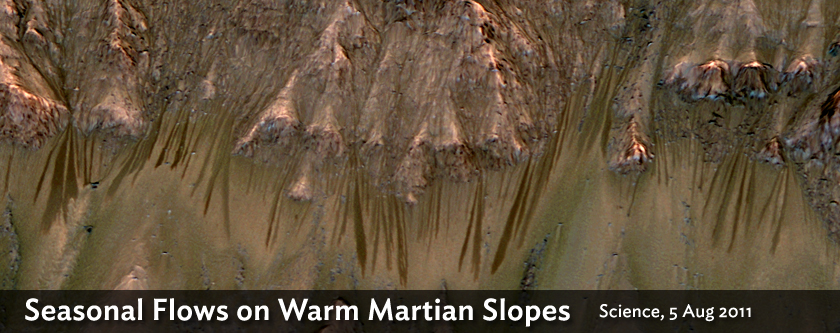Alfred S. McEwen, Lujendra Ojha, Colin M. Dundas, Sarah S. Mattson, Shane Byrne, James J. Wray, Selby C. Cull, Scott L. Murchie, Nicolas Thomas, Virginia C. Gulick
ABSTRACT
Water likely flowed across ancient Mars, but whether it ever exists as a liquid on the surface today remains debatable. Recurring slope lineae (RSL)
are narrow (0.5-5 m), relatively dark markings on steep (25°-40°) slopes; repeat MRO/HiRISE images show them to appear and incrementally grow during
warm seasons and fade in cold seasons. They extend downslope from bedrock outcrops, often associated with small channels, and hundreds of them
form in rare locations. RSL appear and lengthen in the late southern spring/summer from 48°S to 32°S latitudes favoring equator-facing slopes--times and places with peak surface temperatures from ~250-300 K. Liquid brines near the surface might explain this activity, but the exact mechanism and source of water are not understood.
Animated GIFs to illustrate activity of Recurring Slope Lineae (RSL), described in the 5 August 2011 Science paper.
All of these animated GIF files consist of a series of orthorectified HiRISE images over locations with RSL activity. Orthorectification
corrects oblique images to show how the scene would appear from directly overhead.
Each GIF is timed to dwell 2 seconds on the first and last frames and 1 second on intermediate frames, but network or computer
performance may cause this to vary. The legend on each image gives the exact HiRISE image identifier available on the rest of this website. You can
view the accompanying text
for these animations as a PDF.
The legend also marks the year and seasonal identifier (Ls) for each image. The Mars years begin with the first years of Mars exploration
by robot spacecraft. Ls stands for areocentric longitude of the sun, dividing the year into 360 degrees to mark the seasons.
Ls = 180 is the beginning of southern spring, Ls = 270 is the beginning of southern summer, and Ls = 360 (or 0) is the beginning
of southern autumn.
If you need assistance or have a question about our orthorectified images, please
contact us.
News agencies: As a courtesy, we ask you credit as: Image: NASA/JPL/University of Arizona
